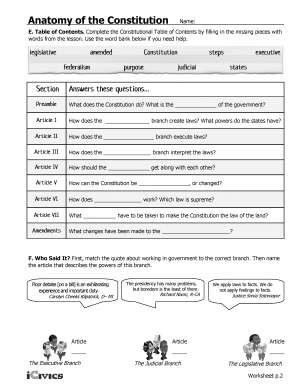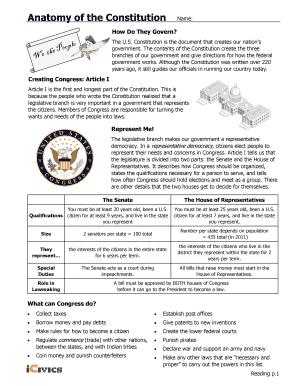It’s hard to imagine a time when the United States wasn’t a republic governed by a Constitution, but it actually wasn’t always this way. Before the Constitution was drafted and ratified in 1787, the thirteen colonies were governed by the Articles of Confederation, a much weaker agreement that failed to provide a strong central government. The Articles lacked the ability to enforce laws or tax, making it difficult for the fledgling nation to function effectively. It was this weakness that led to the Constitutional Convention and the creation of the Constitution we have today. But this creation was far from simple. It required careful consideration of how to create a government that was powerful enough to function, but not so powerful as to infringe on individual liberties. The result was a document that was, and remains, a work of genius.

Image: www.icivics.org
The Constitution is a living document, meaning that it has evolved over time to reflect the changing needs of our country. The Bill of Rights, for example, was not part of the original Constitution but was added later by the first ten amendments. The Constitution has been amended many times since, with the most recent amendment being the 27th, which was adopted in 1992. These amendments have shaped the course of our nation, ensuring that our government remains accountable to the people and that individual rights are protected.
Understanding the Structure of the U.S. Constitution
The Constitution is divided into seven articles, each of which covers a different aspect of our government. The first article lays out the powers of the legislative branch, known as Congress. This branch is bicameral, meaning it is composed of two separate chambers, the House of Representatives and the Senate. The second article covers the executive branch, which is led by the President of the United States. This branch is responsible for enforcing the laws passed by Congress. The third article establishes the judicial branch, which is headed by the Supreme Court. With the other lower federal courts, the judicial branch is responsible for interpreting the laws passed by Congress and enforced by the executive branch.
The remaining articles of the Constitution deal with various other aspects of our government, such as the process for amending the Constitution, the relationship between the federal government and the states, and the process for admitting new states into the union. Each article is crucial to understanding the foundation of American government, and together they form a framework for how our country is governed.
The Importance of the Bill of Rights
The first ten amendments to the Constitution are collectively known as the Bill of Rights. These amendments were added to the Constitution in 1791 after a heated debate between Federalists, who supported a strong central government, and Anti-Federalists, who believed that the Constitution needed to explicitly protect individual liberties.
The Bill of Rights enshrines fundamental freedoms that are at the core of American democracy. These include:
- Freedom of religion: The First Amendment guarantees the right to practice any religion or no religion at all.
- Freedom of speech: The First Amendment also protects the right to express oneself freely, even if those views are unpopular or controversial.
- Freedom of the press: The First Amendment protects the right of the press to publish information without government interference, which is crucial for a free and democratic society.
- Freedom of assembly: The First Amendment protects the right to gather peacefully with others, which is important for political activism and social justice movements.
- Freedom to petition the government: The First Amendment protects the right to petition the government for redress of grievances, allowing individuals and groups to express their concerns to the government and seek solutions to problems.
The other amendments in the Bill of Rights protect important individual rights, including the right to bear arms, the right to a fair trial, and the right to protection from unreasonable searches and seizures.
How to Interpret the Constitution
Interpreting the Constitution is a complex process that involves carefully considering the text, its historical context, and its application in previous cases. Judges, lawyers, and scholars engage in debates about the meaning of the Constitution, drawing on various sources to reach their conclusions. There are several different methods of interpreting the Constitution that have been used throughout history, including:
- Originalism: This method emphasizes the original intent of the framers of the Constitution. Originalists argue that the Constitution should be interpreted in light of the framers’ understanding of the text and its meaning at the time it was written.
- Textualism: This method focuses on the plain meaning of the words of the Constitution. Textualists believe that the words should be interpreted literally and that judges should not look beyond the text itself to determine the meaning.
- Living Constitutionalism: This method argues that the Constitution should be interpreted in light of contemporary values and social conditions. Living constitutionalists believe that the Constitution is a dynamic document that must evolve to meet the changing needs of society.
The method of constitutional interpretation can significantly influence legal outcomes, as different approaches can lead to different interpretations of the same text. This is why debates about the meaning of the Constitution are often heated and complex.

Image: www.uslegalforms.com
The Constitution in the 21st Century
The Constitution is a timeless document that continues to serve as the foundation for our government in the 21st century. It has been tested by numerous challenges, from the Civil War to the Civil Rights Movement, and has always emerged stronger. But the Constitution is not static. It must be continually adapted and interpreted to address new issues and challenges facing our nation. For example, the legal battles over same-sex marriage and the right to privacy in the digital age have forced us to reconsider the meaning of certain constitutional provisions in the context of the 21st century. As technology and society continue to evolve, the Constitution will undoubtedly continue to be debated and interpreted in new ways.
As we move forward, the Constitution will continue to serve as a guide for our government and a symbol of our shared commitment to democracy. It is a reminder of the freedoms we enjoy and the responsibility we have to protect them.
Tips for Understanding the Constitution
The Constitution, though lengthy, is accessible to all. Learning the basics is essential for understanding American democracy and how our government functions. Here are some tips for deciphering its contents and applying its principles:
- Read the text yourself: The Constitution is readily available online, and taking the time to read it can be incredibly enlightening.
- Explore resources: Many excellent websites, books, and other resources can help you understand the Constitution.
- Connect the Constitution to current events: Think about how the Constitution impacts the issues facing our country today.
- Engage in discussion: Talk to your friends, family, and community members about the Constitution and its importance.
By engaging with the Constitution and understanding its principles, you become a more informed citizen and contribute to the continued health of our democracy.
FAQ: Anatomy of the Constitution
Q: What is the purpose of the Constitution?
A: The Constitution serves as the supreme law of the land, laying out the structure, powers, and limitations of the U.S. government. It also defines the basic rights and freedoms guaranteed to citizens.
Q: Who wrote the Constitution?
A: The Constitution was drafted by delegates from all thirteen states at the Constitutional Convention in Philadelphia in 1787. James Madison played a key role in drafting the document and is often referred to as the “Father of the Constitution.”
Q: How many articles are in the Constitution?
A: There are seven articles in the U.S. Constitution.
Q: Why was the Bill of Rights added to the Constitution?
A: The Bill of Rights was added to address concerns about individual liberties and to ensure that the government could not infringe on these fundamental rights.
Q: How many amendments are there to the Constitution?
A: There are twenty-seven amendments to the U.S. Constitution.
Anatomy Of The Constitution Answer Key
Conclusion: An Enduring Legacy
Understanding the anatomy of the Constitution is not just about memorizing dates and facts but about grasping the principles that underpin American democracy. The Constitution is a testament to our nation’s history, its values, and its potential. By understanding this document, we can become more engaged citizens, participate in the process of shaping our democracy, and ensure that the Constitution continues to serve as a beacon of hope for generations to come.
Are you interested in learning more about the Constitution and its role in American society? We encourage you to dive deeper into this fundamental document and continue your journey of exploring its timeless relevance.




